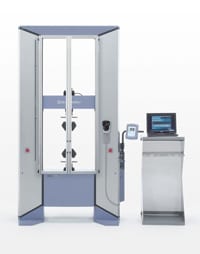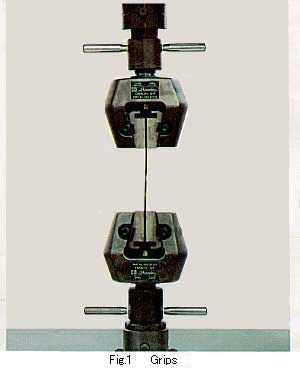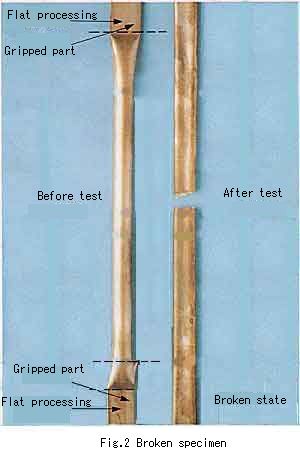Static Tensile Test of Small Pipe Selection of Optimal Grips and Extensometers (II)

The mechanical properties of aluminum and copper pipes, often used in air conditioners and in various precision instruments, must be evaluated in the form of their actual use.
Static tests are conducted with both ends of the pipe specimen processed flat and the center portion remaining in the form of a pipe, while conventional testing methods are performed by inserting a core into the gripped part of the specimen to prevent crushing.
Actual test conditions and test results are introduced below.

Specimen
| Material | : | Copper pipe |
| Size | : | outer diam. 12.5mm, thickness 0.5mm |
| Optimal shape of gripped portion | : | Specimen is processed flat at each end. (See Fig. 2) |
Testing conditions
| Testing machine | : | Shimadzu Universal Testing Machine AUTOGRAPH |
| Load cell | : | Capacity 100kN |
| Testing speed | : | 30mm/min |
| Distance between grips | : | 300mm |
Examples of optimal grips
| Grip | : | Manual non-shift wedge type grip (See Fig.1 picture) or Hydraulic non-shift wedge type grip (for 100kN) |
| Grip face | : | Standard cross-file teeth |
Extensometer for gauge length displacement
| Type of extensometer | : | Breakage extensometer for hard specimens (measurement by magnetic scale) |
| Gauge length | : | 50mm |

Fig 2 shows that the specimen is normally broken not at the gripped part, but near the center of the parallel part of the specimen.
Fig.3 and Table 1 indicate that the test data (tensile strength and elongation at max. load) for four specimens had very little fluctuation and also that the breakage extensometer for hard specimens is very effective for measuring the gauge length elongation of pipe materials.
Table 1 Results
| Specimen No. | Elongation at max. load | Tensile Strength | Elongation | |||
|---|---|---|---|---|---|---|
| kN | {kgf} | Mpa | {kgf/mm2} | mm | % | |
| 1 | 3.5 | 358.0 | 225.5 | 23.0 | 100.2 | 33.5 |
| 2 | 3.5 | 360.0 | 227.5 | 23.2 | 101.5 | 33.8 |
| 3 | 3.6 | 370.0 | 230.4 | 23.5 | 100.0 | 33.3 |
| 4 | 3.5 | 360.0 | 227.5 | 23.2 | 92.0 | 30.6 |


